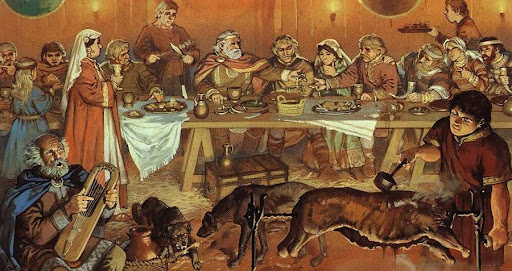
Originating in Scandinavia, Yule also known as yuletide, is a festival celebrated in honor of winter solstice and the passing on of souls to the afterlife. Traditionally Yule was observed by Germanic peoples but it is now celebrated by neo-pagans. In modern times some pagans still try to recreate ancient traditions whereas others have adapted yule to fit their own beliefs and practices. The date of Yule changes yearly based on when the winter solstice occurs, but it is typically celebrated towards the end of December. This year it will be celebrated from December 21st to January 1st.
Yule is theorized by historians to come from the Norse holiday Jul and the English holiday Geohol. Jul was a holiday meant to celebrate the up-and-coming new year and to bring prosperity into the new year. Geohol was a holiday celebrated after the last hunting period for the winter. Historians believe that Yule once included traditions of sacrifice and worship to the god Odin. The god Odin is the god of war and death and is depicted as a man with a long white beard riding an eight-legged horse. During Yule, he rides across the sky battling souls and sending them to the afterlife.
Yule’s celebrations were believed to bring prosperity and a good new year. The festival was typically celebrated as a huge feast and could last up to 12 days depending on the Northern European region. Due to the harsh cold climate of Northern Europe, cattle and other livestock were all slaughtered early on in the winter months, allowing for this large feast. Many traditions go along with Yule that inspired Christmas traditions. One of the most popular traditions that isn’t just associated with Yule is a Yule tree. Although very similar to a Christmas tree its origins are not, in ancient times Vikings would decorate evergreen trees with offerings like food, wood carvings, and other hand-crafted gifts. The oldest and possibly one of the most important traditions is the yule log, which in ancient times was the log primarily used in the fire on the night of winter solstice. The yule log represents health and prosperity for the year but was also used to ward off bad spirits on the night of winter solstice. Yule oaths were also a popular tradition among ancient Norse, the rule of a Yule oath is you may promise anything but it can never be broken if sworn on Yule.
In modern times neo-pagans still appreciate old traditions but many times things are done very differently from how they used to be done. Pagans and countries who celebrate yule culturally still get together for a huge feast honoring the year’s yields and next year’s prosperity. The yule tree has evolved quite a bit, instead of an evergreen decorated in food and offerings you’ll more commonly find a pine or fir decorated with handmade ornaments in the homes of a pagan. Instead of the yule log which would burn throughout yule is now most commonly honored with a “yule log cake” a delicious cake made to look like a piece of wood. The only tradition that stayed is the course was yule oaths, neo- pagans still take oaths under the pagan law on yule. These oaths are still taken extremely seriously just like in ancient times.
Yule is still celebrated widely across many northern European countries such as Sweden and Scandinavia. Yule’s traditions have been modernized and changed heavily but the true meaning of the holiday continues to live on.






